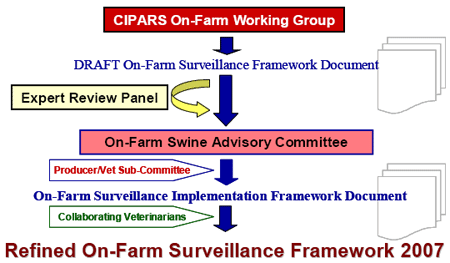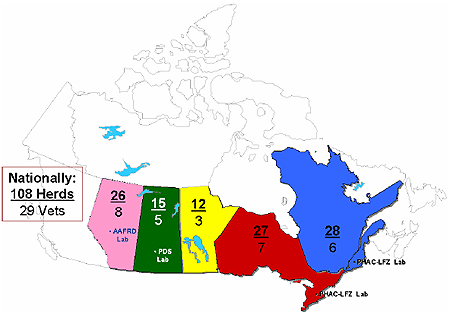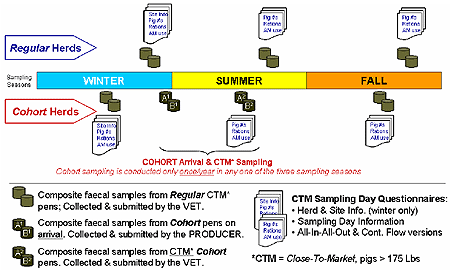Common menu bar links
Institutional links
Diseases & Conditions
Health & Safety
Research & Statistics
Agency Information
Search Box
E-mail this page
Canadian Integrated Program for Antimicrobial Resistance Surveillance (CIPARS)
Surveillance
- Abattoir
- Animal Clinical Isolates
- Feed
- Human clinical Isolates
- On-Farm
- Research Submission Form (Updated: 28 november 2008)
(Please download the document by right clicking on the link and choose: "Save Target As" or "Save Link As" )
- Summary of 2006 Activities - Retail
Collaborative Research Opportunity
The CIPARS On-Farm Swine Program is a sentinel site surveillance system involving 108 grower-finisher units in Alberta, Saskatchewan, Manitoba, Ontario, and Québec. The program collects fecal samples, antimicrobial use data, and a small amount of supplementary information three times per year on each site. Salmonella, generic E. coli and Enterococcus are cultured from the fecal samples and antimicrobial susceptibility testing is performed on the isolates. Refinements to the program are being considered which may impact the number and frequency of samples obtained in 2009
There is an opportunity for researchers to utilize the infrastructure of this program to conduct specific research projects. The number of projects undertaken at any one time will be limited. This is NOT A FUNDING OPPORTUNITY. Researchers are responsible for obtaining the funding required to conduct their research. Projects with approved funding will be given priority. Researchers should also be aware that the CIPARS On-Farm Swine Program was largely funded by the Agriculture Policy Framework (APF) initiative; APF funding for the CIPARS On-Farm Swine Program ended in March 2008. Additional funding has been secured for 2009. However, the future of this infrastructure beyond 2009 is uncertain; the CIPARS On-Farm program may discontinue sampling and data collection if sufficient new funding is not obtained. Samples and isolates collected up to March 2010 will be available.
Interested researchers should submit a CIPARS On-Farm Swine Program Research Submission Form to the CIPARS group by Dec 19, 2008. This form can be found at http://www.phac-aspc.gc.ca/cipars-picra/surv_farm-eng.php. The next deadline for submissions will be November 1st, 2009.
For further information on the CIPARS On-Farm Swine Research Submission
process please contact: Diane Sanjenko at Diane_Sanjenko@phac-aspc.gc.ca or
Louise Bellai at Louise_Bellai@phac-aspc.gc.ca.
For additional information on the CIPARS program, please visit:
http://www.phac-aspc.gc.ca/cipars-picra/surv-eng.php
On-Farm
In 2006, the CIPARS On-farm surveillance program was implemented in Canadian swine herds across five major pork producing provinces. This program was developed after extensive consultations with commodity groups and the provinces. Once the decision was taken to conduct a pilot program with the grower-finisher swine industry, Review and Advisory Committees were created to assist the CIPARS On-Farm working group in the development of a surveillance framework (Figure 1). The swine industry was selected as the pilot commodity for surveillance infrastructure development because there is extensive implementation of the Canadian Quality Assurance (CQA®) program by the industry, there was the absence of a recent foreign animal disease outbreak and there was a similar initiative in swine in the United States (Collaboration in Animal Health and Food Safety Epidemiology). Upon completion of the program’s first year and after consultation with collaborators, program refinements were implemented in 2007.
FIGURE 1. Surveillance framework design process

The objectives of the CIPARS On-farm surveillance program are:
- To establish infrastructure to support a national surveillance program.
- To provide data on antimicrobial use and resistance.
- To investigate associations between antimicrobial use and resistance.
- To provide data for human health risk assessments.
FIGURE 2: Distribution of sentinel herds and veterinarians

Antimicrobial use data are collected using sampling day
questionnaires and CQA® forms. Pooled fecal samples are
collected from pens of close to market weight finisher hogs three
times annually (Figure 3). In a subset of herds, specific
cohorts of pigs are followed. Cohort pens have pooled fecal samples
collected at arrival and again at close-to-market. All fecal
samples are cultured for generic E. coli, Enterococcus and Salmonella, and quantitative
antimicrobial susceptibility testing is performed using the
Sensititre® Microbiology System (Trek Diagnostic Systems  , Cleveland, OH, USA).
, Cleveland, OH, USA).
FIGURE 3. Schematic: Sampling & Data Collection
In addition to providing data on antimicrobial use and resistance in the Canadian swine industry, CIPARS On-Farm will offer a research platform for specific antimicrobial resistance and animal health studies. On-farm surveillance provides unique challenges in logistics, data management, confidentiality, and providing representative data. CIPARS On-Farm will provide valuable information to help refine methodologies for antimicrobial use and resistance surveillance. This surveillance system will inform the development of antimicrobial use guidelines and policy by industry and government. The system will also provide critical information on the logistics, resources and support required for a broader, sustainable multi-commodity national surveillance system for both antimicrobial resistance, zoonotic enteric pathogens, and animal health pathogens.
Summary of 2006 Activities
Preliminary results from the 2006 sampling year are currently being analyzed. Veterinarians and producers will be receiving farm specific results in August of 2007. Antimicrobial use data is being entered into a computerized database and will be available in late 2007.
In 2006, 324 visits were planned and 89% (287) of these visits were completed. The total number of samples collected was 442. To date 65 annual questionnaires and 89 sampling day questionnaires have been received. Ninety two (21%) and 93 (21%) of the total samples were cohort arrival and close-to-market samples respectively. Two hundred and fifty seven (58%) regular close-to-market samples were also collected. Almost 80% (442) of the expected samples were available for testing. Of the samples submitted, 2189 E. coli (5 isolates per E. coli positive samples isolated), 92 Salmonella sp (1 isolate per Salmonella positive samples isolated) and 946 Enterococcus sp. (3 isolates per positive sample) have been isolated.

